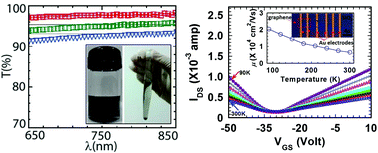Non-oxidative, controlled exfoliation of graphite in aqueous medium†
Abstract
We present a simple, non-oxidative and controlled method to synthesize graphene monolayers by exfoliation in water from different solid carbon sources, such as highly ordered pyrolytic graphite and low density graphite. Any water based method is highly desirable due to several attractive features, such as environmental friendliness, low cost and wide compatibility with other water based processes. We show that thin graphene layers can be exfoliated controllably and reproducibly by varying different parameters during exfoliation in aqueous medium. It has been possible to obtain high quality graphene monolayers with a yield of ∼2.45 wt%, which can be increased up to 16.6 wt% by recycling the sediments. Field effect transistors based on exfoliated graphene monolayers have shown n-type doping and a high carrier mobility of 4500 cm2 V−1 s−1 at room temperature and ∼20 000 cm2 V−1 s−1 at low temperature. Density functional calculations corroborate the infrared spectroscopic results and also indicate that the charge transfer preferentially occurs from water molecules to the graphene sheets resulting in n-type doping. We anticipate that exfoliation of high quality graphene layers in aqueous medium would open up a pathway for various graphene based electronic and biological applications.


 Please wait while we load your content...
Please wait while we load your content...